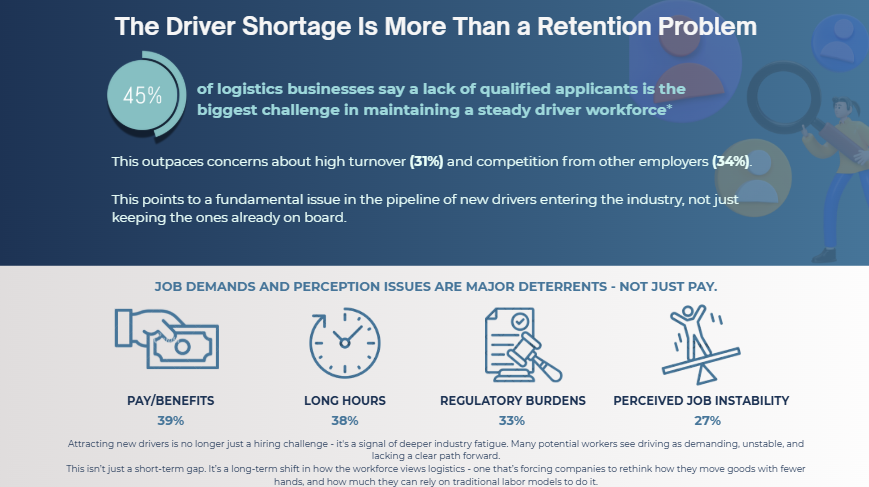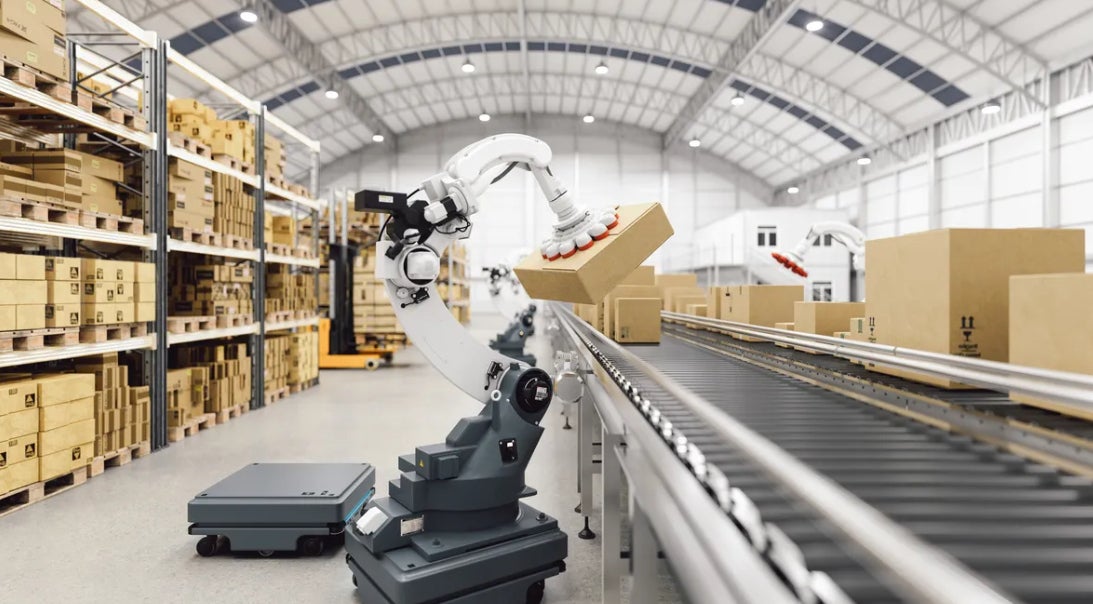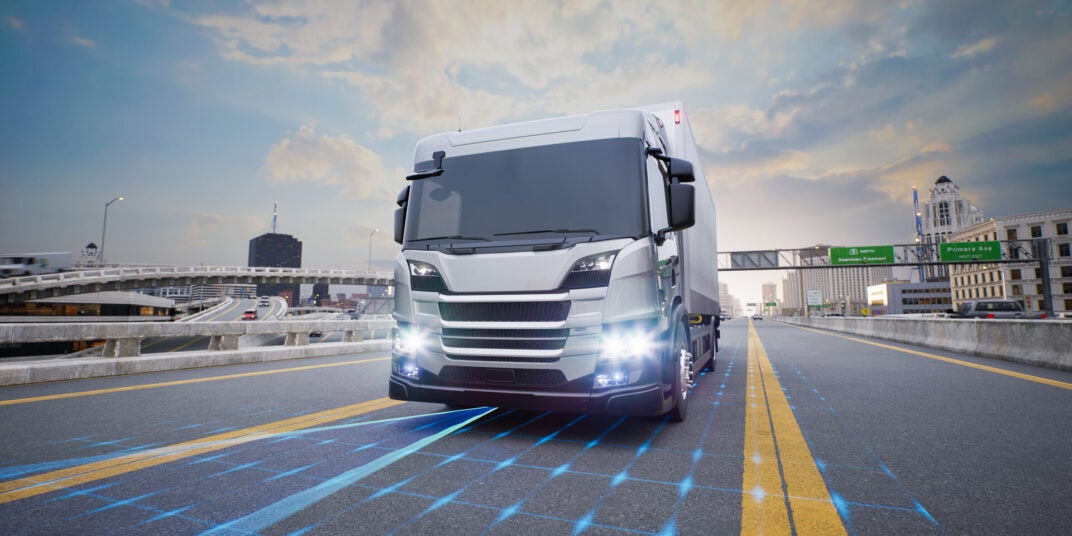Autonomous trucks have long been heralded as the future of the logistics industry, with the potential to solve the hiring crisis, boost efficiency, and ultimately pull freight firms back from the brink of ruin. But how far away are we from that dream becoming a reality?
With no federal ruling on the autonomous trucks issue, individual states have been forced to hand down their own mandates, which has created the fragmented regulatory landscape that we see at the moment. On top of this, the technology doesn’t yet have universal buy-in, with detractors citing concerns over health and safety, liability, and the threat to the existing workforce.
But participants in our latest survey, Moving Goods With Fewer Hands, have largely reached a consensus — 42% of them believe that we’ll see self-driving trucks on the road in the next 15 years, with just a fraction (14%) believing that it won’t happen until after 2050.
So which verdict is closer to reality? In this guide, I’ll lay out the landscape and assess whether or not autonomous trucks really are the future.
Autonomous Trucks: Where Are We At the Moment?
As mentioned, while the promise of driverless trucks may be impossible to ignore, they haven’t yet revolutionized the industry in the way that its advocates had hoped. This is partly due to the absence of federal guidance on the issue. Specifically, what level of permission do businesses have to operate their autonomous vehicles? Are they only permitted on roads without any other vehicles on?
Silence from the White House has prompted state governments to mete out their own rulings on autonomous trucks, giving rise to a tangle of different regulations and mandates. In Arizona, for instance, companies have been testing self-driving trucks on the road since 2019. But in Hawaii, there is no legislation that explicitly permits the testing of driverless trucks.
What’s more, these edicts have arrived at different times, and are thus in different stages of ratification. Some states, such as Alaska, have proven notoriously tight-lipped on the whole issue. Others, including Texas, were quick off the mark to enshrine policy into law. Ultimately, this inconsistent landscape has made it difficult for manufacturers to secure testing permission, with only a handful of states currently welcoming self-driving trucks on their roads.
Another significant roadblock comes in the form of autonomous vehicle critics. Commonly, they point to concerns over safety and liability, with the high-profile case of Elaine Herzberg casting a long shadow over the space. In 2018, Herzberg was struck and killed by a self-driving Uber test vehicle that had a human operator in attendance. A protracted court case followed, with Uber eventually found not liable for her tragic death.
Not only does the case weigh heavily on decisionmakers, but it lends credibility to the argument that self-driving trucks are unsafe. Of course, there’s a clear counterpoint to this belief — the overwhelming majority of vehicular crashes are caused by human error. But it’s enough to give people pause for thought.
Thirdly, opponents argue that autonomous trucks spell disaster for the existing human workforce. While freight bosses will point to longstanding hiring concerns, with 69% saying that this has impacted their ability to meet demand, AI skepticism abounds. When it comes to emotional issues like job security and financial outlook, these opinions will not be easily swayed.
And as our survey demonstrates, most people in the industry do not believe that autonomous trucks are ready to be rolled out. If given the choice between hiring a new, human driver or using a driverless truck for a “standard route,” 70% of respondents confirmed that they would opt for the new hire.
Ultimately, these factors have slowed progress in the driverless truck space. But the tide is turning.
The Case For Autonomous Trucks
In this section, I’ll break down the benefits that driverless trucks could bring to freight owners and the logistics industry as a whole. Chiefly, they have the potential to solve the ongoing labor crisis by reducing reliance on drivers.
As respondents to our Moving Goods With Fewer Hands survey have indicated, a lack of qualified applicants is the single biggest obstacle to maintaining a steady workforce. Other factors include competition from other employers (34%), high turnover (31%), ageing workforce (25%), and more.

A breakdown of which factors are contributing the driver shortage. Source: Tech.co research
This is having a major impact on freight firms’ abilities to meet demand, leading to delayed deliveries, backlogs at ports, and broken supply chains. In the longer term, the impacts could be devastating. With firms making fewer deliveries, merchants will take their business elsewhere — putting freight companies at serious economic risk. Smaller businesses, in particular, face an uphill struggle to see off the threat posed by logistics titans such as FedEx and DHL.
Self-driving trucks can also make fleets much safer. A shocking 94% of traffic crashes are caused by human error, according to the National Highway Traffic Safety Administration. While driverless trucks are not infallible, they significantly reduce the margin for human error. This is great news for your insurance premiums, and means that you’ll save money on repairs and vehicle replacement.
With autonomous trucks, every aspect of your fleet’s performance will be improved. For example, you can optimize your route planning and operation, reduce downtime, and operate round the clock without the need for rest breaks. Driverless trucks can make more deliveries in a shift, and will enhance your overall vehicle performance, with less engine idling and optimized acceleration and braking to keep fuel costs low.
The Case Against Autonomous Trucks
On the other side of the coin, this technology does come with its share of drawbacks, which I’ll discuss in the following section. Among them, there are valid concerns around the displacement of human jobs.
The logistics staffing problem is dire, and autonomous trucks are a genuinely compelling solution to make up the shortfall. But once the industry has clawed itself out of its present rut, will there be fewer driving positions available because of self-driving vehicles? It’s highly likely. As a matter of fact, this will be felt right across the industry, with automation poised to turn the freight business on its head.

A robotic arm operating in a warehouse. Source: CFO Dive
Furthermore, there are genuine safety concerns with autonomous trucks. While human error is significantly reduced, these vehicles currently have issues with unexpected obstacles and poor weather conditions.
According to New Scientist, they’re worse at handling turns and operating in low light. And with a limited vehicle accident database stymieing development, researchers will be unable to overcome this problem in the near-future.
Self-driving trucks also carry inherent cybersecurity risks. In November 2024, Tesla was forced to recall over 570,000 driverless vehicles that were equipped with “Autopilot,” a driver assistance system. Autopilot had recently undergone a software update that caused poor object identification. The consequences could’ve been fatal for drivers.
As well as highlighting possible software vulnerabilities within self-driving vehicles, the incident served as a note of caution for the future. If driverless trucks make it to public roads, vehicle manufacturers and cybersecurity researchers will have to work in close collaboration to ensure that their systems are watertight.
Looking Ahead: Are Autonomous Trucks the Future of Logistics?
In recent years, clamor for automated tech has skyrocketed. Machines and systems that can take repetitive and strenuous tasks off our hands have been touted as the future of the workplace, and logistics is no exception. We’ve already begun to see the impact that automation is having in the warehouse and elsewhere across the supply chain.
Self-driving trucks, however, have yet to make their mark on the industry. Largely, this is due to legal wrangling. But the problem won’t last forever, which begs the question — are self-driving trucks the future of logistics?
Undoubtedly, this technology has a massive role to play in getting the industry back on its feet and paving the way for a healthier future. But worry not — humans will continue to be an essential part of supply chains everywhere. By working together, we can all look forward to a logistics industry operating at the top of its game.

